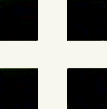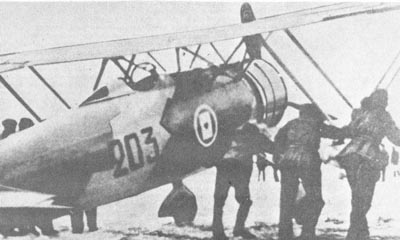Hungary

Zászlós Márton ‘Lapaj’ Szönyi
Hungary

Zászlós Márton ‘Lapaj’ Szönyi
Between October 1938 and May 1940 approximately 200 Hungarian pilots (including Márton Szönyi, Károly Baranyai and Lajos Göcsei) got their theoretical and flying training in Grottaglie, near Taranto (South Italy). The theoretical instructors were Hungarians and the flying instructors were Italians. The reasons for these arrangements were Hungary's “peace” dictate after the First World War (military flying was forbidden until 1938 for Hungarians).
Zászlós (Ensign) Szönyi was attached to 1/3. vadászszázad (1/3. Fighter Squadron) at the time of the assault on Soviet Union. The unit was equipped with Fiat CR.42s.
At 04:30 on 11 August, a record number of five out of the six Caproni Ca.135bis took off and performed a successful bombing raid on Nikolayev. They also attacked a strategic bridge over the Bug River close to the city. The bombers were joined by their unusually strong fighter escort – comprising six CR.42s of the 1/3. vadászszázad and five Re.2000s of the 1/2. vadászszázad led by százados László Tomor – over Pervomaysk airfield. Loaded with captured Soviet 100kg bombs, the Capronis flew out over the Black Sea east of Odessa before making a wide circle to surprise the city’s defence by coming from the south-east. The leading aircraft, with flight leader föhadnagy István Szakonyi at the controls, released its bomb load on the central railway station from 3000m. The other bomber raj (flight) bombed the bridge.
The Hungarian encountered strong anti-aircraft fire. The starboard engine of B.517, the aircraft flown by föhadnagy Szakonyi, was hit by shrapnel, causing the aircraft to lose speed and lag behind the rest of the formation. The lone Caproni was then attacked by six I-16s but despite repeated attacks from various angles, the fighters couldn’t score a fatal hit. Moreover, the bomber’s two gunners claimed three of the attackers. Örmester János Bánkuti (radio operator) reported shooting down two and szakaszvezetö János Mester (flight engineer) one. One of the I-16s had positioned itself in the bomber’s blind spot as it closed in from behind for the kill but was jumped at the last minute by a CR.42, who promptly shot it down. Soon after this episode, the bomber reached friendly territory but because of the extensive damage sustained during the combat, the pilot decided to land at the larger Pervomaysk airfield. Once on firm ground, the exhausted crew counted 42 bullet holes in their aircraft yet none of the five crewmembers – which included a supernumerary, Staff alezredes Sándor András – was even lightly wounded.
Another second flight bomber was also attacked by three I-16s while leaving the target area. One of them was claimed as shot down by the radio operator. Soon afterwards, the lone Caproni was able to find sanctuary in clouds and escape the fighters’ further attention. A third Hungarian bomber escaped a trio of I-16s which were engaged by a pair of CR.42s. One of the I-16s was shot down and the survivors were forced to disengage.
Meantime, on their way from Nikolayev, the remaining Hungarian bombers were attacked by nine Soviet I-16s. They were immediately engaged by the escorting CR.42s and a wild męlée developed, involving six Hungarian biplanes and nine Soviet monoplanes with the Re.2000s joining in. The Hungarian fighters flew above the bombers when they left the target area and when the Russian leader selected the first Caproni he was intercepted by szakaszvezetö Lajos Göcsei and hadnagy Albert Seres. A turning dogfight followed but the Hungarian CR.42s stayed behind the desperate Russian until Göcsei found himself in a favourable position. He sent a long burst into the fuselage of the I-16, flames leapt from the aircraft and it fell towards the ground like a spinning torch. Almost at the same time zászlós Miklós Kun had shot down another I-16 which just flew in front of his machine guns. When Tomor rejoined the bombers, he discovered a lone I-16 behind one of the Capronis. He dived on the enemy and shot it down in flames. At the same time, zászlós Szönyi and zászlós Baranyai, who were escorting a crippled Caproni (föhadnagy Szakonyi’s Ca.135), encountered two I-16s and shot them down promptly. Seres), who flew back to search for the two fighters and the bomber, saw the two Soviet fighters hitting the deck. This was the 1/3. "Kor Ász" vadászszázad first five claims during the Second World War and all CR.42s were hit but none were lost. The claimants were the squadron CO százados Tomor, zászlós Kun, zászlós Szönyi, zászlós Baranyai and szakaszvezetö Göcsei (the latter shared with hadnagy Seres.
1/2. Vadászszázad claimed three victories when szakaszvezetö Kálmán Gémes, százados László Gyenes and föhadnagy Tamás Móry claimed one each. However, Reggiane V.420 of föhadnagy Gyula Lasztóczy was missing (possibly shot down by flak) and this was the 1/2. vadászszázad first combat loss.
The Soviet 9 IAP-ChF claimed three enemy aircraft shot down near Nikolayev. However, two of its pilots, squadron CO Kapitan Aleksey Kolobkov, together with Leitenant Leonid Danchenko, were shot down in air combat in the Nikolayev area. Both were KIA.
During the next days the vadászszázad flew several sorties over the industrial centre of Dniepropetrovsk. On 26 August, hadnagy Albert Seres’ section flew a sortie over the city and was engaged in combat with Soviet I-16s. Seres and zászlós Szönyi claimed two I-16s each while zászlós Baranyai claimed a fifth I-16. Baranyai’s aircraft was damaged during this combat and he was wounded himself but managed to bring back his fighter. He was patched up by the medics and flew again the next day.
It seems that they had been in combat with 88 IAP, which misidentified them as Ar 197s. The Soviet pilots claimed one victory.

On 27 August, zászlós Szönyi was rammed by starshii leitenant P. N. Maltsev of 88 IAP (his second and last claim) in a ‘taran’ ramming attack over Dniepropetrovsk and taken POW during the day. It is possible that he claimed a victory before he was shot down but there aren’t any witnesses to this claim. Maltsev managed to land his damaged I-16.
Later on he was “re-educated” by the NKVD and trained in sabotage and diversion techniques. Alongside other Hungarian and Soviet agents and saboteurs he was dropped over Hungary on 8 August 1944.
On 7 September 1944 he was killed by Hungarian csendör (gendarme) troops.
Totally Szönyi claimed 3 victories, all of them while flying Fiat CR.42, before he was captured.
Claims:
| Kill no. | Date | Time | Number | Type | Result | Plane type | Serial no. | Locality | Unit |
| 1941 | |||||||||
| 1 | 11/08/41 | 04:30- | 1 | I-16 (a) | Destroyed | Fiat CR.42 | Nikolayev area | 1/3. vadászszázad | |
| 2 | 26/08/41 | 1 | I-16 | Destroyed | Fiat CR.42 | V-203 | Dniepropetrovsk area | 1/3. vadászszázad | |
| 3 | 26/08/41 | 1 | I-16 | Destroyed | Fiat CR.42 | V-203 | Dniepropetrovsk area | 1/3. vadászszázad | |
| 27/08/41 | 1 | ”I-17” | Probably destroyed | Fiat CR.42 | V-203 | Western Ukraine | 1/3. vadászszázad |
Biplane victories: 3 destroyed, 1 probably destroyed.
TOTAL: 3 destroyed, 1 probably destroyed.
(a) Claimed in combat with I-16s from 9 IAP-ChF, which claimed three enemy aircraft while losing two. The Hungarian fighters and bombers claimed 12 I-16s while losing one Re.2000.
Sources:
Becze Csaba: A magyar királyi 1. honvéd éjjeli vadász repülöszázad Magyar Repüléstörténeti Társaság Konferencia Közleményei 1999 kindly provided by Csaba Stenge
Biplane Against The Red Bear - Julius R. Gaal, 1974 Air Combat Spring/1974 kindly provided by Santiago Flores
Fejezetek a magyar katonai repülés történetéböl - S. Nayyváradi, Miklós M. Szabó and L. Winkler, 1986 kindly provided by Dénes Bernád
From Barbarossa to Odessa: Volume 2 – Dénes Bernád, Dmitriy Karlenko and Jean-Louis Roba, 2008 Ian Allan Publishing Ltd, ISBN 978-85780-280-1
Harcok az orosz égen Budapest - László Tomor, 1942 kindly provided by Csaba Stenge
Additional information kindly provided by Csaba Stenge and Dénes Bernád.


